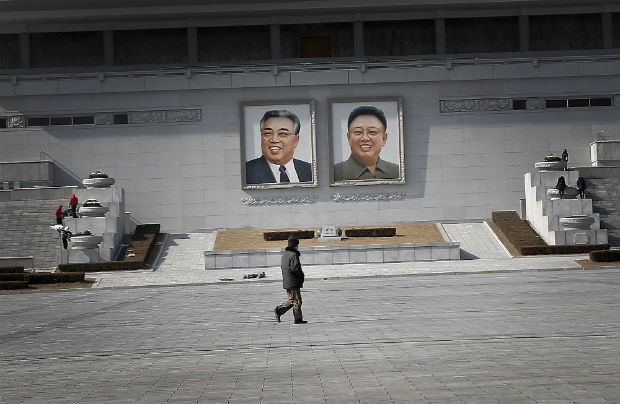Seoul: Pyongyang used money from joint factories for weapons

A man walks past portraits of the late North Korean leaders Kim Il Sung and Kim Jong Il, at the Kim Il Sung Square on Sunday, Feb. 14, 2016, in Pyongyang, North Korea. North Korea launched a rocket Feb. 7, carrying what it said was an Earth observation satellite into space. AP
SEOUL, South Korea — North Korea channeled about 70 percent of the money it received for workers at the now-shuttered Kaesong industrial park into its weapons programs and to buy luxury goods for the impoverished nation’s tiny elite, South Korea said Sunday.
The jointly run park, just outside the North Korean city of Kaesong and about 50 kilometers (35 miles) from Seoul, employed some 54,000 North Koreans who worked for over 120 South Korean companies, most of them small and medium-sized manufacturers. Seoul closed the park last week in retaliation for Pyongyang’s recent rocket launch.
In a statement issued Sunday, South Korea’s Unification Ministry said that about 70 percent of the 616 billion won ($560 million) paid to the North since the park was established in 2004 was used to develop nuclear weapons, missiles and for the luxury goods.
It did not detail how it arrived at that percentage.
Pyongyang was able to divert the money because the workers in Kaesong were not paid indirectly. Instead, U.S. dollars were paid to the North Korean government, which siphoned off most of the money and paid only what it wanted to the employees in North Korean currency and store vouchers, the statement said.
Article continues after this advertisementPyongyang responded to Seoul’s closure by announcing a military takeover of the complex and seizing everything that the companies’ South Korean managers were forced to leave behind.
Article continues after this advertisementThe last major symbol of inter-Korean cooperation began during an era of relatively good cross-border relations, combining cheap North Korean labor with the capital and technology of wealthy South Korea.
But Seoul is desperate to pressure Pyongyang after its nuclear test earlier this year, followed weeks later by a Feb. 7 rocket launch, which was condemned by the rest of the world as a test of banned missile technology. While the Kaesong closure will hurt North Korea, it is not critical to that nation’s economy. Pyongyang gets the vast majority of its earnings from trade with China.
The last time the park closed was in 2013, when North Korea withdrew its workers amid escalating tension in the wake of North Korea’s third nuclear test. The park reopened after about five months.